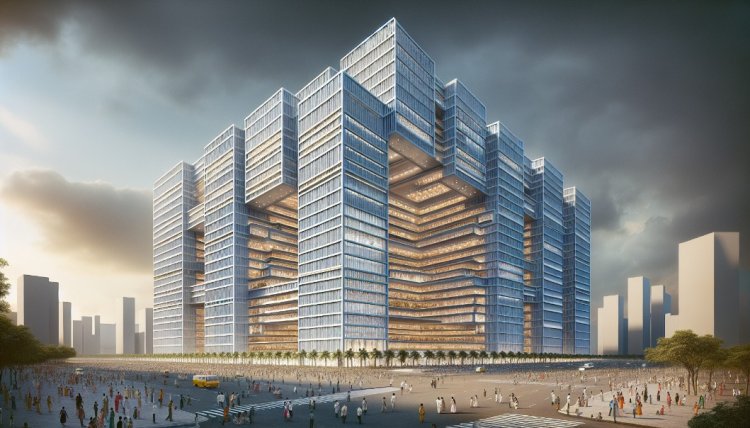Surat Diamond Bourse (SDB): Building the World's Largest Office: A Milestone for India's Construction Industry
"Discover Surat Diamond Bourse (SDB), the world's largest office building, a remarkable milestone in India's construction industry. Learn about its innovative design, economic impact, and significance in the global diamond trade."

Introduction
What structure holds the title of the world's largest office building? Surprisingly, it's not the Pentagon. A sizable new development in the Indian city of Surat won this prestigious title in December. Spanning over 7 million square feet, this colossal office building has become a milestone for India's construction industry.
Constructing a building of this magnitude presented numerous specialised requirements and challenges. The architects had to consider the efficient flow of tens of thousands of people, consistent light conditions for diamond viewing, and the extreme climate of Surat, with its stifling heat and monsoon rain.
Despite the global trend of empty office spaces due to the rise of hybrid work, the Surat Diamond Bourse (SDB) had guaranteed full occupancy even before construction began. The SDB was created to address the inefficiencies in Surat's diamond industry, where rough stones were processed in small workshops and then transported to Mumbai for trade.
The importance of this building in the age of hybrid work cannot be overstated. It consolidates India's diamond industry under one roof, fostering collaboration and streamlining operations. Additionally, the SDB has become an iconic structure, driving tourism and symbolising resilience in the face of the pandemic.
Surat: The Diamond Hub
Surat, located in the western Indian state of Gujarat, holds significant importance in the diamond industry. With approximately 90% of the world's diamonds being cut and polished in Surat, it is a major hub for the diamond trade.
However, the diamond processing and trading process in Surat has been inefficient. Rough stones are transported to small workshops scattered around the city for processing, and then they need to be transported to Mumbai, over 200 kilometres away, for trading.
This inefficient process led to the formation of the Surat Diamond Bourse (SDB), a centralised location that aims to streamline operations and foster collaboration in India's diamond industry. A group of nearly 5,000 diamond-related businesses in Surat commissioned the SDB.
The Surat Diamond Bourse is an enormous building, worth $388 million, designed to house all aspects of India's diamond industry under one roof. It includes 4,700 offices and can accommodate 67,000 people, including cutters, polishers, merchants, and traders.
The architects at Morphogenesis faced several challenges in designing such a massive building. They had to ensure the efficient flow of tens of thousands of people in and out of the building, consistent light conditions for diamond viewing, and the ability to withstand Surat's stifling heat and monsoon rain.
To address these challenges, the architects designed a building with nine, fifteen-story towers flanking a 400-metre central spine. This layout allows for efficient distribution of people and ensures that every office receives ample daylight for diamond viewing.
The building's spine also helps cope with Surat's extreme climate. It funnels prevailing winds throughout the complex, providing 50% of the building's cooling needs. The communal spaces in the spine and courtyards emulate the environment diamond traders are accustomed to, where trade is often conducted under a tree while enjoying a cup of tea.
Construction of the Surat Diamond Bourse faced challenges, especially during the COVID-19 pandemic. Sourcing materials from a closer radius became necessary as global supply chains dried up. However, despite these challenges, the building was completed in four and a half years, with over 6,000 people involved in the construction process.
The Surat Diamond Bourse has already become an iconic structure, driving tourism and symbolising resilience in the face of the pandemic. It consolidates India's diamond industry, promotes collaboration, and streamlines operations, making it a milestone achievement for Surat and the diamond industry.
Designing a Building for Efficiency
When constructing a building as large as the Surat Diamond Bourse, efficiency becomes a critical factor. The architects, Morphogenesis, faced several challenges in designing a structure that could accommodate the needs of thousands of people while maintaining consistent lighting conditions and withstanding Surat's extreme climate.
Challenges of accommodating a large number of people
With 67,000 people working in the Surat Diamond Bourse, an efficient flow of people was a top priority for the architects. They aimed for every employee to reach their office within seven minutes of entering the gate, which required careful planning and traffic simulations.
To achieve this, the building was designed with nine, fifteen-story towers flanking a 400-metre central spine. This layout resembled a fishbone vertebrate, which efficiently distributes nerve signals from the brain to the rest of the body. The towers and distances between them were calculated to ensure that every office receives ample daylight and is not overshadowed.
Considerations for consistent lighting conditions
Consistent lighting conditions were crucial for diamond viewing within the offices. Deep floor plans or a building with a skyscraper design wouldn't provide enough access to daylight. To address this, the architects aligned the building north to south, allowing each office to receive 100% daylight without being overshadowed by other parts of the building.
The decision to use multiple towers and a central spine
The choice of multiple towers and a central spine not only facilitated efficient flow of people and consistent lighting conditions but also helped the building cope with Surat's extreme climate. The spine of the building flares out to the west to catch prevailing winds, which are funnelled throughout the complex and provide 50% of the building's cooling needs.
In addition to its functional benefits, the central spine and courtyards within the building emulate the environment diamond traders are accustomed. These communal spaces allow traders to conduct business under a tree while enjoying a cup of tea, creating a familiar and comfortable atmosphere.
Utilising natural ventilation for cooling needs
Surat's stifling heat and monsoon rain posed a challenge for the architects. To address this, they designed the building to take advantage of natural ventilation. The flared ends of the central spine capture prevailing winds and funnel them throughout the complex, providing a significant portion of the building's cooling needs.
By utilising natural ventilation and designing the building with efficiency in mind, the Surat Diamond Bourse not only meets the needs of its occupants but also symbolises resilience in the face of the pandemic and drives tourism to the city.
Construction Challenges and Adaptations
Building the world's largest office building comes with its fair share of challenges. From managing the timeline and workforce for construction to sourcing materials locally during the pandemic, the architects and builders had to adapt and find solutions to ensure the successful completion of the Surat Diamond Bourse.
Timeline and workforce for construction
With a project of this magnitude, it was crucial to carefully plan the timeline and manage the workforce. Over 6,000 people were involved in the construction process, working tirelessly for four and a half years to bring the building to life. The efficient flow of workers and coordination between different teams were essential to ensuring smooth progress and timely completion.
Sourcing materials locally during the pandemic
The COVID-19 pandemic posed unique challenges for sourcing materials globally. To overcome this, the decision was made to source materials locally within a 500-kilometer radius. This approach ensured a more reliable supply chain and reduced the risk of delays due to global disruptions. Materials such as ceilings and ceramic tiles were manufactured nearby, while an on-site fabrication plant was set up to manufacture unitized glazing using raw glass from a nearby factory.
Onsite fabrication plant for manufacturing
To streamline the construction process and ensure quality control, an onsite fabrication plant was established. This plant was responsible for manufacturing the unitized glazing used in the building. By having the capability to produce these units on-site, the project team could closely monitor the manufacturing process and make any necessary adjustments promptly. This approach also minimised transportation costs and reduced the risk of damage during transportation.
Future plans for expansion with Dream City
The completion of the Surat Diamond Bourse is just the beginning of a larger plan. The building is the first phase of Dream City, a seven-square-kilometer smart city that aims to provide additional housing and office space for the diamond industry. Despite the uncertainties in the global economy and the challenges faced by the jewel market, the Surat Diamond Bourse has already become an iconic structure and a symbol of resilience. It has driven tourism to the city and sparked conversations about architecture in everyday life.
Impact and Legacy of the Building
The Surat Diamond Bourse, as the world's largest office building, has made a significant impact and left a lasting legacy in several ways.
The building's significance for architecture in India
The design of the Surat Diamond Bourse is not only functional but also innovative. The architects, Morphogenesis, tackled the challenges of accommodating a large number of people, ensuring consistent lighting conditions, and coping with Surat's extreme climate. The unique layout of nine towers flanking a central spine, efficient flow of people, and emphasis on natural ventilation set a new standard for large-scale office buildings in India.
Driving tourism and interest in Surat
The Surat Diamond Bourse has become an iconic structure, attracting tourists and sparking conversations about architecture in everyday life. People are eager to visit and study the building, which has elevated Surat's reputation as a prominent city in the diamond industry. The building's grandeur and significance have put Surat on the map as a must-visit destination for architecture enthusiasts.
Symbolic importance during the pandemic
Amid the COVID-19 pandemic, the Surat Diamond Bourse symbolizes resilience and hope. Despite global uncertainties and challenges, the building was completed within the planned timeline, showcasing the determination and adaptability of the construction industry. Its completion and success serve as a beacon of optimism, reminding people of the power of human ingenuity and the ability to overcome obstacles.
Inspiring the next generation of builders
The Surat Diamond Bourse has inspired and captivated the imagination of aspiring builders, architects, and designers. Its groundbreaking design and engineering solutions demonstrate what is possible in the world of construction. By pushing the boundaries and reimagining traditional office building designs, the Surat Diamond Bourse has set a new standard and inspired the next generation to think creatively and innovatively in their own projects.
The legacy of the Surat Diamond Bourse extends beyond its physical presence. It exemplifies the power of architecture to shape communities, drive economic growth, and inspire future generations. As India's construction industry continues to evolve, the Surat Diamond Bourse stands as a testament to the country's potential for groundbreaking architectural achievements.



 admin
admin 










